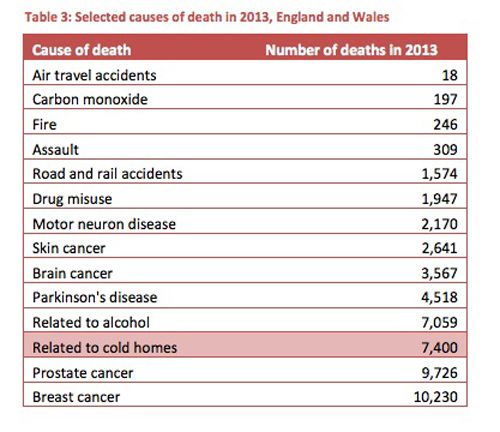

Recent research by the Association for the Conservation of Energy (ACE) for the Energy Bill Revolution has highlighted the number of excess winter deaths in the UK. These deaths are primarily due to illnesses brought on by the cold.
It is important to understand the role of cold homes in causing these deaths, as ACE argue keeping homes warm is a huge opportunity for the government to tackle one of the main root causes of excess winter deaths.
It is estimated by the World Health Organisation that 30% of these excess winter deaths are due to people living in cold homes. These deaths could be prevented if people were kept warm during the winter months.
To calculate the number of cold home deaths during the last five years of this Parliament, ACE has taken the official figures for excess winter deaths for 2010/11 to 2012/13, used the provisional figure for winter 2013/14 and calculated an estimate for this last winter, 2014/15. The findings show:
- 158,880 excess winter deaths have occurred in the UK over the last five winters
- Around 47,660 of these deaths in the last five winters are due to people living in cold homes
- This winter will have seen the highest rate of excess winter deaths and cold home deaths in the last five years. ACE estimate that there will have been 49,260 excess winter deaths this winter, of which around 14,780 are due to people living in cold homes.
- This winter has seen an increase in excess winter deaths of 77% above the average.
Homes which are inefficient and unaffordable to heat can have serious health impacts. Cold conditions worsen chronic lung disease and asthma, suppress the immune system and reduce capacity to fight off infection, leading to an increased risk of bronchitis and pneumonia (Donaldson, 2010). Cold housing increases the level of minor illnesses such as colds and flu and exacerbates arthritis and rheumatism (Marmot Review Team, 2011).
These impacts do not only harm elderly people; research by ACE for the Energy Bill Revolution found families and children also suffer, with children in cold homes being more likely to experience breathing problems. Mental health is also negatively affected by fuel poverty and cold housing, for people of all ages (Marmot Review Team, 2011).
Cold homes are estimated to burden the NHS with costs of £1.36 billion per annum (Fuel Poverty Advisory Group, 2015).
In 2013, in England and Wales, cold homes killed over four times as many people as road and rail accidents; nearly four times as many people as drug misuse; and about as many people as alcohol. In terms of number of deaths, cold homes were 30 times more lethal than fire.
According to ACE, investment in making homes highly energy efficient can be increased significantly by making this a UK infrastructure capital spending priority. The UK Treasury has plans to spend £100 billion of public money on infrastructure over the course of the next Parliament. Investing just three per cent of this budget in making homes highly energy efficient, alongside existing energy efficiency budgets, can bring two million UK low income homes up to a high standard of energy efficiency (EPC Band C) by 2020.
ACE feel this would create the world’s most ambitious home energy efficiency programme, reducing cold home deaths, slashing energy bills and carbon emissions, creating over 100,000 jobs and reducing costs for the NHS.
